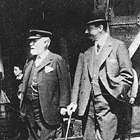Titanic (By Tony Sze)
| From Idea to Reality | |
 Titanic
is a word which originates from Greek mythology. The Titans were a race of
giants reputed for their great size and force, and were eventually
overthrown by the Olympian gods. The word "titanic" in English
now likewise means "of, relating to, or held to have characteristics
of the Titans," or "marked by very great size : of enormous
magnitude, power, scope, strength, or influence : colossal,
gigantic." Titanic was just the sort of name the White Star Line was
seeking for the sister ships that were to be its newest triumvirate of
transatlantic steamers. Titanic
is a word which originates from Greek mythology. The Titans were a race of
giants reputed for their great size and force, and were eventually
overthrown by the Olympian gods. The word "titanic" in English
now likewise means "of, relating to, or held to have characteristics
of the Titans," or "marked by very great size : of enormous
magnitude, power, scope, strength, or influence : colossal,
gigantic." Titanic was just the sort of name the White Star Line was
seeking for the sister ships that were to be its newest triumvirate of
transatlantic steamers. |
|
 In
1907, five years before Titanic would set sail, J. Bruce Ismay
(photo below left, on right), managing director of the White Star Line,
and Lord William James Pirrie (photo below, left), chairman of the
shipbuilder Harland and Wolff, met for dinner in London. In
1907, five years before Titanic would set sail, J. Bruce Ismay
(photo below left, on right), managing director of the White Star Line,
and Lord William James Pirrie (photo below, left), chairman of the
shipbuilder Harland and Wolff, met for dinner in London.  It
was on this night that the two discussed plans for three new liners that
would be like nothing the world had seen. Harland and Wolff and the White
Star Line had a very loyal partnership, but White Star had major
competition from the Cunard line, who was enjoying great success with the Mauretania
and Lusitania and their speed records for crossing the Atlantic.
As ships were the only means for crossing the oceans in this era, and as
an Atlantic crossing transit still took several days, people would
inevitably spend a significant amount of time on ocean liners. White Star
and Cunard understood this – while Cunard’s priority was generally
speed, backed by their revolutionary turbine engines, The White Star Line
had generally opted for the more comfortable and slightly slower voyage.
While White Star maintained this philosophy, the size and luxury of the
newly conceived liners held promise to outdo the Cunard ships in more than
one respect. The White Star flagships would have both reciprocating steam
engines, the norm for the period, and a turbine engine to power the center
of three propellers. Moreover, a double plated hull and a sophisticated
system of watertight compartments provided the utmost in security. It
was on this night that the two discussed plans for three new liners that
would be like nothing the world had seen. Harland and Wolff and the White
Star Line had a very loyal partnership, but White Star had major
competition from the Cunard line, who was enjoying great success with the Mauretania
and Lusitania and their speed records for crossing the Atlantic.
As ships were the only means for crossing the oceans in this era, and as
an Atlantic crossing transit still took several days, people would
inevitably spend a significant amount of time on ocean liners. White Star
and Cunard understood this – while Cunard’s priority was generally
speed, backed by their revolutionary turbine engines, The White Star Line
had generally opted for the more comfortable and slightly slower voyage.
While White Star maintained this philosophy, the size and luxury of the
newly conceived liners held promise to outdo the Cunard ships in more than
one respect. The White Star flagships would have both reciprocating steam
engines, the norm for the period, and a turbine engine to power the center
of three propellers. Moreover, a double plated hull and a sophisticated
system of watertight compartments provided the utmost in security. |
|
 The
three Royal Mail Steamships were to be called Olympic, Titanic,
and Gigantic. It was the tradition of the White Star Line to
adjectivize its ships with the suffix "ic," thus describing the
liners as well as naming them. They were to be virtually identical in size
and structure, but Titanic was to be the true shining star. On
the 29th of July, 1908, White Star, including Ismay, came to the shipyard
of Harland and Wolff in Belfast, Ireland to review the tentative plans for
the conception of the ships. The creation of these initial plans was under
the direct supervision of Thomas Andrews (right), the managing director
and senior draftsman for Harland and Wolff. Andrews oversaw virtually
every detail from blueprint to maiden voyage. About a year and a half
after the idea was born for the White Star Titans, the keel was laid for
the firstborn, Olympic. The
three Royal Mail Steamships were to be called Olympic, Titanic,
and Gigantic. It was the tradition of the White Star Line to
adjectivize its ships with the suffix "ic," thus describing the
liners as well as naming them. They were to be virtually identical in size
and structure, but Titanic was to be the true shining star. On
the 29th of July, 1908, White Star, including Ismay, came to the shipyard
of Harland and Wolff in Belfast, Ireland to review the tentative plans for
the conception of the ships. The creation of these initial plans was under
the direct supervision of Thomas Andrews (right), the managing director
and senior draftsman for Harland and Wolff. Andrews oversaw virtually
every detail from blueprint to maiden voyage. About a year and a half
after the idea was born for the White Star Titans, the keel was laid for
the firstborn, Olympic. |